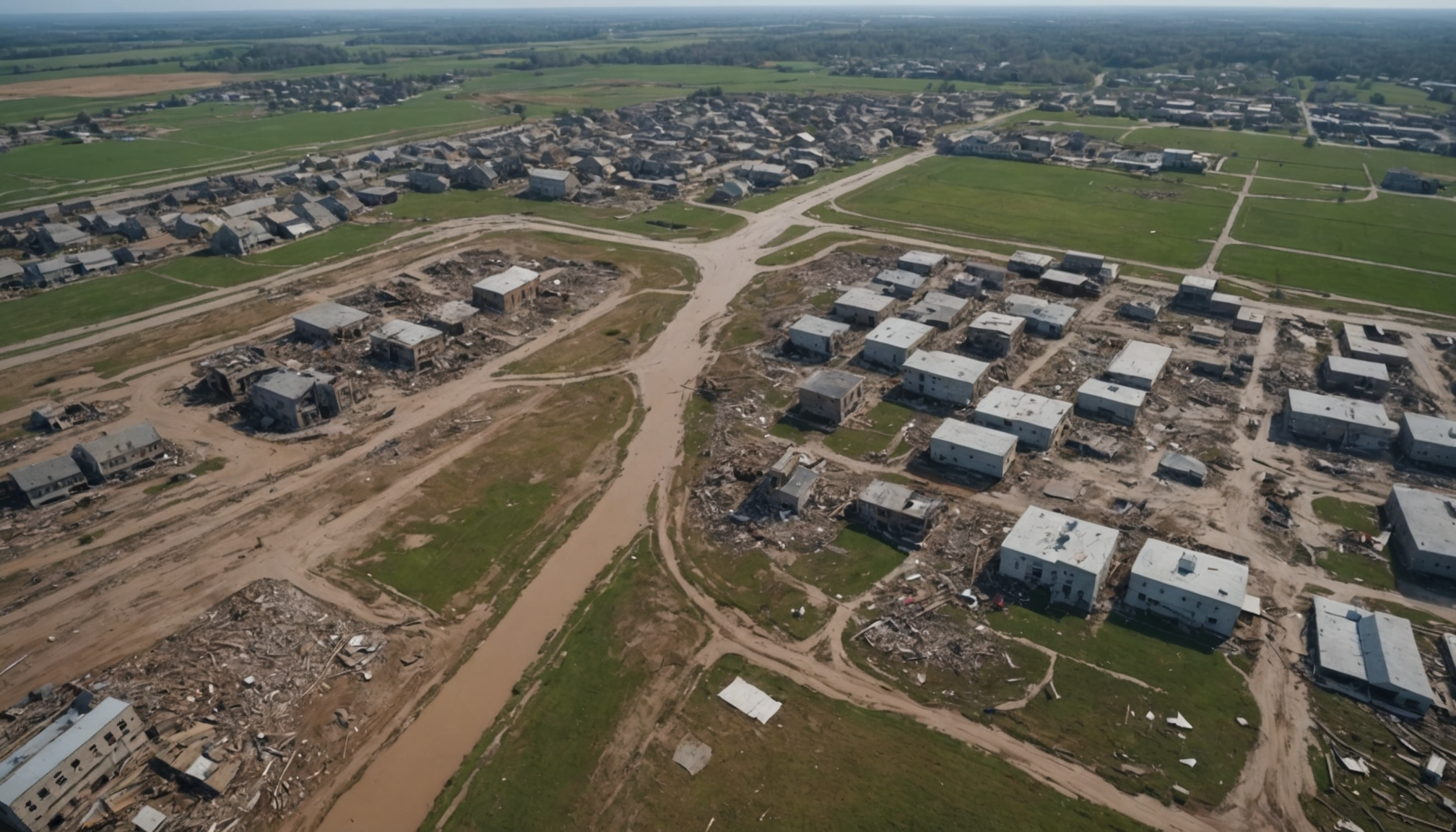In the aftermath of a storm, determining the extent and nature of the destruction is a critical first step in disaster recovery. This process, known as damage assessment, provides the necessary information for informed decision-making and prioritization of resources. It involves systematically evaluating the affected area to identify the type and extent of damage, which aids government agencies, relief organizations, and the community in coordinating effective response and recovery efforts.
Damage assessment typically begins with rapid reconnaissance of the affected areas to gather preliminary data. This initial evaluation helps to provide a general picture of the situation, allowing stakeholders to quickly gauge the scale of the disaster and identify the most devastated locations. A more detailed, secondary assessment follows, integrating on-site inspections, aerial surveys, and satellite imagery. These advanced methodologies enable a comprehensive understanding of both visible and hidden damages, such as structural failures, infrastructure disruptions, and environmental impacts.
The assessment process involves various components, including:
- Structural Assessment: Identifying collapsed or weakened buildings and infrastructure, which is vital for safety and evaluating repair needs.
- Infrastructure Analysis: Examining roads, bridges, utility services, and communication networks to determine disruptions and plan restoration activities.
- Environmental Impact Assessment: Analyzing changes to landscapes, waterways, and ecosystems that could have long-term consequences for the area.
To effectively prioritize and allocate resources, a comparison between affected regions is often necessary. This comparison typically includes considerations such as population density, severity of damage, and critical infrastructure needs. Below is a general framework for comparing different impact zones:
| Criterion | Zone A | Zone B | Zone C |
| Population Density | High | Moderate | Low |
| Severity of Structural Damage | Severe | Moderate | Mild |
| Essential Services Availability | None | Partial | Available |
| Priority for Resource Allocation | High | Medium | Low |
Coordination and communication among agencies are crucial during damage assessment to ensure accurate data collection and sharing. Leveraging technology such as drones and GIS systems can greatly enhance the precision and efficiency of these assessments. Moreover, engaging local communities and stakeholders in the evaluation process provides crucial on-the-ground insights and fosters community involvement in the recovery efforts.
Ultimately, the outcomes of the damage assessment drive the subsequent steps in disaster recovery, from mobilizing emergency response teams to planning long-term redevelopment. By thoroughly understanding the damage landscape, authorities and communities can better strategize their interventions to address both immediate needs and long-term restoration effectively.
mobilizing emergency response
Once the damage has been assessed, mobilizing an efficient emergency response is the next critical step in disaster recovery. This phase focuses on deploying resources and coordinating services to meet the urgent needs of affected communities, ensuring that help reaches those who need it most. Here’s how the process typically unfolds:
- Activate Emergency Operations Centers: In the initial hours following a disaster, local and regional emergency operations centers (EOCs) are activated. These centers serve as the central hub for coordinating response efforts, facilitating effective communication between various governmental and non-governmental agencies.
- Deploy First Responders: On-the-ground emergency personnel, including police, fire, and medical teams, are among the first to be mobilized. Their immediate task is to conduct search and rescue operations, provide medical assistance, and ensure public safety. Detailed briefings and trained coordination ensure that these teams work effectively amidst challenging and dynamic conditions.
- Provision of Essential Supplies: Ensuring the distribution of essentials such as food, water, medicine, and temporary shelter is paramount. Logistics teams coordinate the transport and delivery of these supplies to strategic locations, often using emergency vehicles, helicopters, or boats, depending on the accessibility of affected areas.
- Establish Communication Channels: Efficient communication is essential for effective emergency response. This involves setting up temporary communication networks if existing infrastructure is damaged, using technologies like satellite phones and portable radios. Public information officers are tasked with providing consistent updates to keep both responders and the public informed.
- Deploy Specialized Teams: Depending on the circumstances, specialized units such as hazardous materials teams, engineers, and mental health professionals may be deployed to address specific challenges, ranging from environmental hazards to providing psychological support to victims.
- Coordinate with Non-Governmental Organizations (NGOs): Collaboration with humanitarian organizations is crucial. These NGOs bring additional manpower and resources, enhancing the overall capacity to provide aid. Memorandums of understanding and pre-established partnerships often facilitate smoother integration of these valuable resources into the broader emergency effort.
- Implement Incident Management Protocols: Utilizing an Incident Command System (ICS) helps streamline responsibilities, ensuring clear leadership and organized operations. This system allows for scalable and flexible response management adapted to the size and scope of the disaster.
- Assess and Adapt Response Activities: Continuous monitoring of the situation allows for the assessment of response effectiveness. Using feedback loops and established review processes, responders can adapt their strategies to emerging needs and unforeseen challenges, ensuring resources are utilized efficiently and effectively.
This phase is characterized by the urgency of response and the need for collaboration and coordination across various sectors. Effective mobilization of emergency response not only addresses immediate survival needs but also lays the groundwork for subsequent recovery and rebuilding efforts. Consistent training, resource allocation, and clear protocols are vital to ensuring readiness and rapid deployment when disaster strikes.
restoring essential services
Restoring essential services promptly after a disaster is vital to stabilizing affected communities and supporting their return to normalcy. This phase of recovery focuses on the re-establishment of utilities and infrastructure critical to daily living and the overall functioning of society. The process entails strategic planning, resource allocation, and collaboration among government entities, private sectors, and local communities to ensure a seamless transition from chaos to stability.
One of the foremost priorities is the reinstatement of electricity and water services. Electricity is integral to modern living, affecting everything from basic lighting to the operation of hospitals and communication systems. In many disaster scenarios, power lines are downed and substations are damaged, requiring rapid response teams to assess, repair, and restore the electrical grid. Similarly, water services are essential for health and hygiene; broken pipes and contaminated water supplies necessitate prompt attention to prevent the spread of waterborne diseases and ensure safe access to drinking water.
Communication networks are another critical element that requires immediate restoration. After a storm, communication lines are often disrupted, isolating communities and hindering emergency responses. Telecom companies, in partnership with emergency services, work to reinstate both landline and mobile networks swiftly. Innovative technologies like satellite communication and temporary mobile towers can be deployed to bridge gaps, ensuring that residents and responders remain connected during recovery efforts.
Moreover, transportation routes such as roads, bridges, and public transit systems need urgent repair to facilitate movement for both aid distribution and general commuting. Clearing debris, repairing structural damages, and re-establishing public transport are key tasks that enable the flow of resources and personnel necessary for further recovery stages. Efficient transportation systems are also instrumental in reviving local economies, allowing businesses and commerce to resume operations.
Restoring essential services further includes addressing the needs of critical infrastructures such as hospitals and schools. Healthcare facilities are often overburdened in the aftermath of a disaster, making their operational status a priority. Efforts are focused on ensuring that medical supplies, power, and personnel are available to handle the surge in demand. Similarly, reopening schools is a significant step towards community recovery, offering children a sense of normalcy and allowing parents to re-engage in economic activities.
It’s crucial that these efforts are accompanied by robust collaborations between public and private entities. Utility companies, government agencies, and non-profit organizations play integral roles in resource provision, expert guidance, and labor implementation. Such partnerships allow for effective resource mobilization and technical support essential for the swift restoration of services.
By prioritizing the restoration of essential services, communities can recover more quickly and effectively. The dual focus on immediate reparation and long-term resilience planning makes it possible to not only address current disruptions but also mitigate future risks. This systematic approach lays a strong foundation upon which affected regions can build, moving from recovery to sustainable growth and improved disaster preparedness.
supporting affected communities
Empowering and rebuilding affected communities is a critical component of disaster recovery that goes beyond addressing immediate physical and material needs. It’s about providing long-term support that fosters resilience and enables individuals and neighborhoods to rebuild their lives with dignity and purpose. Central to this process is the infusion of resources and services that promote social, economic, and emotional recovery.
One vital aspect of community support is ensuring accessible mental health services. Disasters can have profound psychological impacts, leading to stress, anxiety, and trauma for many individuals. Providing mental health care through counseling services, support groups, and crisis hotlines can significantly aid in emotional recovery. This requires mobilizing trained mental health professionals who can work in collaboration with local support networks to offer compassionate care. Public awareness campaigns highlighting the availability of these services play a crucial role in encouraging individuals to seek help without stigma.
In tandem with mental health support, facilitating economic recovery is essential. Disasters often lead to significant economic dislocation, with businesses damaged, jobs lost, and livelihoods disrupted. Providing financial aid, such as grants and low-interest loans, to affected individuals and businesses can jumpstart economic activity. Offering vocational training and employment programs also helps equip residents with new skills and opportunities, fostering a robust and sustainable local economy over the long term.
Community-driven initiatives are also pivotal in supporting recovery. Encouraging local participation in the rebuilding process empowers residents and ensures that recovery plans align with the community’s needs and priorities. This involvement can include everything from organizing volunteer cleanup efforts to participating in advisory committees that shape redevelopment projects. Collaborative partnerships between government entities, non-profits, and local organizations can create structures that allow community voices to be heard and integrated into planning and decision-making processes.
Education programs focusing on disaster preparedness and resilience-building are fundamental components of helping affected communities recover and prepare for the future. Workshops and training sessions can equip residents with the knowledge and skills needed to better withstand future disasters. By fostering a culture of preparedness, communities become more resilient, reducing the potential impact of future storms and other emergencies.
Ultimately, supporting affected communities encompasses a holistic approach that addresses both the immediate and long-term needs of individuals and neighborhoods. It involves a multi-faceted strategy that incorporates mental health support, economic recovery, community participation, and education and preparedness initiatives. By prioritizing these areas, disaster-struck communities can not only recover but also emerge stronger, more connected, and better equipped to face future challenges.
preparing for future disasters
Preparing for future disasters involves a comprehensive and forward-thinking approach that aims to mitigate the impact of future calamities. As devastating as storms and disasters can be, they serve as valuable lessons that inform better preparedness strategies, ensuring communities can withstand and recover more efficiently from subsequent events.
One of the paramount steps in this preparedness cycle is investing in infrastructure resilience. This involves designing and upgrading buildings, roads, bridges, and utilities to withstand extreme weather conditions. Incorporating flood-resistant materials, elevating structures in flood-prone areas, reinforcing power grids, and constructing stormwater management systems are examples of proactive measures that significantly reduce vulnerability during storms. Governments can offer incentives and enact building regulations that mandate these resilient practices, thus promoting a broader culture of preparedness.
Strengthening emergency management systems is another critical component. Developing robust emergency protocols, conducting regular disaster simulations, and ensuring that all community levels are familiar with these plans can greatly enhance response efficacy. This preparation includes equipping emergency operations centers with state-of-the-art technologies, data systems, and communication tools that facilitate swift coordination and response when disasters strike.
Community education and engagement are equally vital. Implementing awareness campaigns and educational programs helps ingrain a culture of preparedness among residents. Workshops, drills, and training sessions tailored to different population segments—such as schools, businesses, and local organizations—empower individuals with knowledge and skills necessary for emergency response. Engaging communities in these initiatives ensures that action plans are relevant, practical, and community-specific, thereby increasing adherence and effectiveness.
Technological innovation plays a fundamental role in preparing for future disasters. Investing in early warning systems that employ advanced meteorological technology can provide timely alerts to individuals and authorities, allowing for proactive measures such as evacuations or infrastructure shutdowns. In addition, enhancing data collection and analysis capabilities enables a better understanding of patterns and potential vulnerabilities, thus guiding resource allocation and policy formulation.
Finally, fostering collaboration and partnerships across public, private, and non-profit sectors amplifies preparedness efforts. By building networks and agreements in advance, stakeholders can coordinate resources and expertise swiftly when needed. Such partnerships can also drive research and innovation focused on disaster risk reduction, benefiting communities through shared knowledge and resources.
In sum, preparing for future disasters necessitates a holistic and integrated approach that emphasizes infrastructure improvements, emergency management, community engagement, technological adoption, and collaborative efforts. Through these proactive strategies, communities can build resilience not only to withstand forthcoming events but also to recover swiftly and sustainably.
Conclusion: Disaster recovery is a multifaceted process involving immediate response, community support, and future preparedness. By learning from past events and investing in resilient infrastructure, emergency management, and community education, we can significantly enhance our readiness for future disasters. Collaborative efforts across all sectors are crucial in cultivating a resilient society capable of withstanding and quickly recovering from the inevitable challenges posed by natural disasters.


